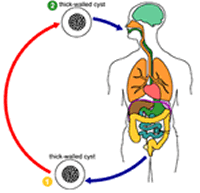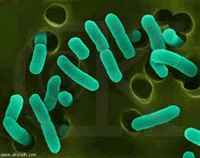
Cyclospora is a protozoa that causes disease in humans, and possibly other primates. In the United States, It has been linked to fecal-contaminated and imported raspberries. It was virtually unknown before about 1990, but has been on the rise since. The health risk associated with the disease is usually confined to adult foreigners visiting endemic regions and acquiring the infection. This is why it has been labeled as causing "traveler's diarrhea."
The time between becoming infected and developing symptoms is unusually long for a disease spread by food -- about 1 week. If not treated, the illness can last for a few days to a month or longer. It also may continue to recur.
Cyclospora infects the small intestine and usually causes watery diarrhea, with frequent, sometimes explosive bowel movements. Other symptoms can include loss of appetite, weight loss, bloating, increased gas, stomach cramps, nausea, vomiting, muscle aches, low-grade fever, and fatigue. However, some people who are infected with cyclospora have no symptoms at all!









